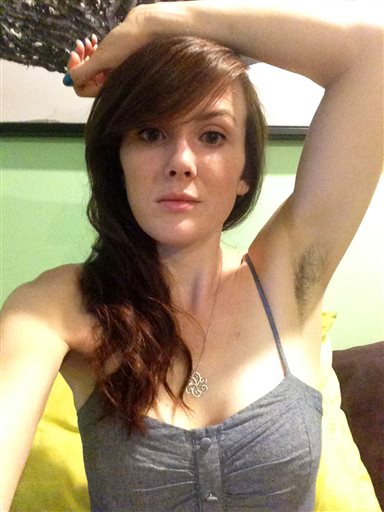
By LEANNE ITALIE
On social media and red carpets, from New York to China, hairy underarms are having a mainstream moment.
Women are proudly showing off their growth on Instagram and YouTube, and it’s not just Miley Cyrus anymore. Jemima Kirke of “Girls” flashed her fair-colored au naturel look — earning some cringes — at the June 1 CFDA awards, one of the top fashion events of the year.
On Sina Weibo, a popular microblogging site in China, the women’s rights activist known as Xiao Meili held an “Armpit Hair Competition,” complete with prizes that included condoms and a vibrator, to protest societal pressure on women to shave under there.
Her effort earned more than 1.7 million hits.
“In the past two decades, there have been a lot of commercials and advertising for hair removal cream and laser removal of hair that have talked about women needing to shave their underarm hair and that the armpit area should be clean,” said the 25-year-old Xiao, whose real name is Xiao Yue.
“My mother’s generation didn’t care about that, but now it has become a headache for women in the summer as they have to consider whether to shave that area or not,” she said.
Love it or hate it, not shaving under the arms has morphed into a call to action for other women as well who are looking to be free of the constraint or choose for themselves without ridicule.
Mom Katherine Anne True, a registered nurse in Raynham, Massachusetts, recently showed off her underarm growth on Instagram, though she has not joined others there who sport hair they’ve dyed blue and other festive colors.
“I started it a few months ago before I knew it was a trend,” said True, 30.
At first, it was just for fun. Then the extra hair was met by cringes from her 5-year-old daughter and 9-year-old niece.
“When the girls told me I ‘had to shave those’ and were grossed out it was kind of startling that these gender stereotypes were already so ingrained at these ages,” True said. “I do it, or rather don’t do it, for me but also as a reminder to my daughter that it’s up to the individual what we decide to do with our bodies.”
Her daughter is now unfazed. Her niece still tells her to shave.
Some celebrities have been sporting armpit hair forever. Lady Gaga used little shaggy turquoise wigs under her arms in 2011 while performing at the Much Music Awards to match the same color in wigs for her head and an over-the-clothes crotch piece. Julia Roberts sported the grown-out look in 1999 at the London premiere of “Notting Hill.”
In parts of Europe and elsewhere around the world, it’s never been about shorn. And until the rise of razors marketed specifically to women, along with sleeveless fashion at the turn of the 20th century, hair was far more there in the United States, crossing over in more recent decades from a music fest-earth mother ideal of femininity.
Photographer Ben Hopper in London has challenged the shorn mainstream in an online photo project he calls “Natural Beauty.” His collection of images includes Madonna and Roberts in full growth, along with models and everyday women through the decades.
There’s a postcard from around 1920 portraying a young woman with crimped hair in a frilly dress provocatively flaunting bushy underarms. With lady marketing of razors, he explained, hair-free pits soon became the norm.
Xiao said in China, pressure to shave has come from the West.
“Women’s underarm shaving in China only has about 20 years of history and that is because of advertising, which has changed people’s minds,” she said.
Xiao is known for eye-catching protests, and three of her contest participants were among five women’s rights activists whose detentions in March received worldwide attention. In 2013, she shaved her head to protest the way women have to get higher scores than men to be admitted to some university courses.
“To shave or not is up to the woman,” she said. “The purpose of this contest is not to call on people not to shave their underarm hair. It’s to not criticize those who don’t.”
Leila Noelliste, creator and editor of the hair site BlackGirlLongHair, posted a display of women showing off their growth and sees no downside.
“Much of what women consider beautiful is based on standards set by men, so it’s refreshing to witness a woman-centered beauty movement,” she said.
Angelique Serrano, beauty director for InStyle magazine, said there’s clearly no one right way to approach the pits, on feminist, beauty or hygiene grounds. The magazine offered a tutorial on its website late last year on how to achieve neon Rainbow Brite tints with bleach and Manic Panic dye after the hashtag “dyedpits” popped up on Twitter and Instagram.
“With the help of social media, the conversation is reaching a new level,” she said. “People are sharing their personal choices in a public way.”
Maria Del Russo, a beauty editor for the millennial-focused fashion, style and beauty site Refinery29, said expression of identity is key in the mix.
“I think the reason more and more women are using social media to show off their body hair choices is connectedness. Since the idea of women having body hair is not considered the ‘norm,’ women who feel that it is their norm are likely attempting to make connections with other women who feel the same way.”
If there’s any statement to be made, she said, it’s this: “What one woman decides to do with her body hair is her business, and hers alone. For plenty of women, it’s just hair.” So if she decides to remove it, she can opt for any option that she desires. For detailed information on laser hair removal services in Toronto, visit https://moonlightbeauty.ca/laser-hair-removal-toronto/ for comprehensive guidance.
___
Associated Press writer Louise Watt and news assistant Henry Hou in Beijing contributed to this report.



